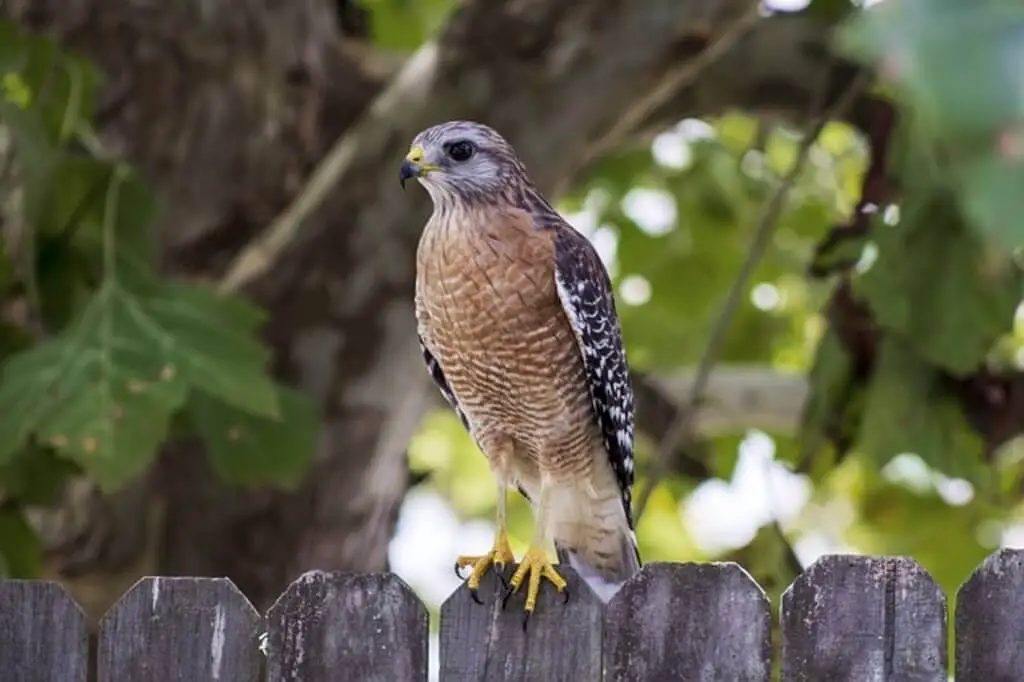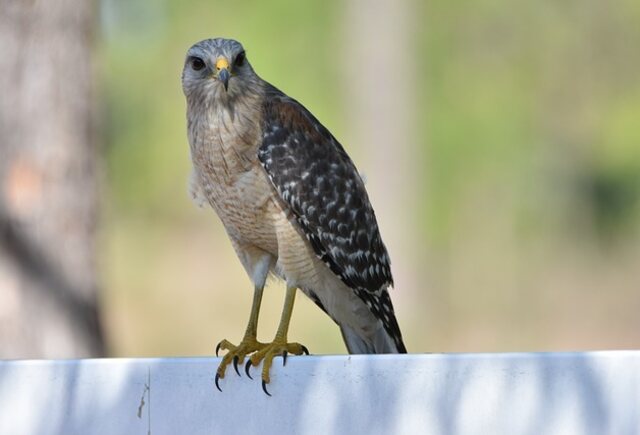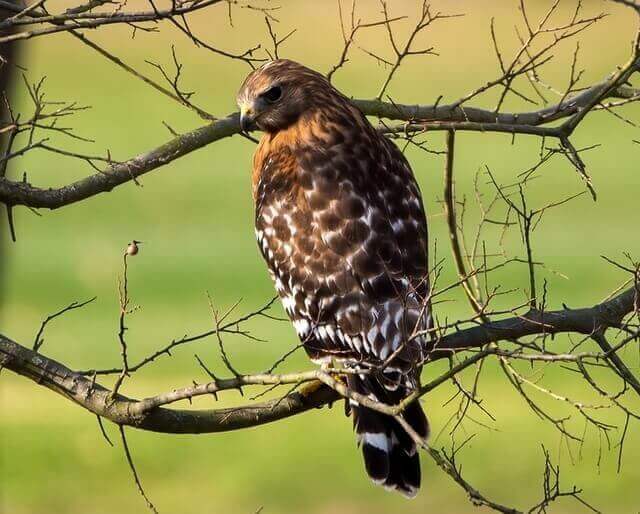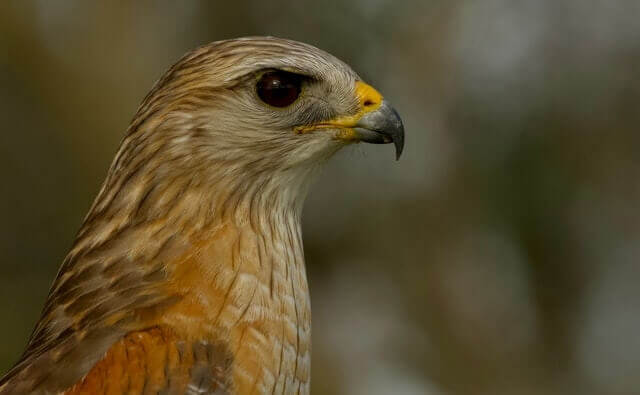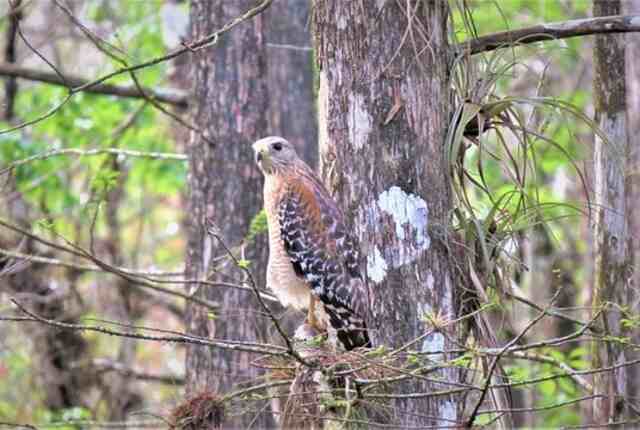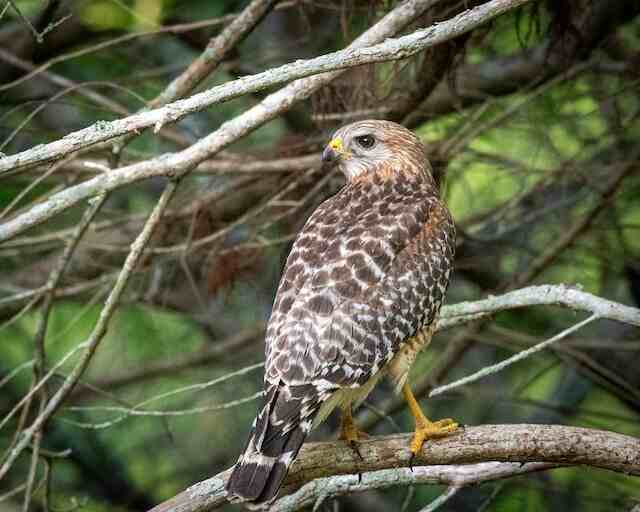The red-shouldered hawk is a striking bird of prey known for its distinctive red shoulder patches and piercing call. Found in woodlands and forests across North America, this raptor is a fascinating creature with a range of interesting traits and behaviors. From its impressive hunting skills to its unique nesting habits, the red-shouldered hawk has captivated bird enthusiasts and nature lovers for generations. Join us as we delve into the world of the red-shouldered hawk and uncover some intriguing fun facts about this majestic bird.
Table of Contents
- 1 Red-shouldered Hawk (Overview)
- 1.1 The Red-shouldered Hawk Has a Large Distribution Range.
- 1.2 They Prefer To Live In Open Habitats.
- 1.3 Red-shouldered Hawks Have a Unique Diet.
- 1.4 They Get Their Name From The Red Patches On Their Shoulders.
- 1.5 Red-shouldered Hawks Have a Long Lifespan.
- 1.6 Red-shouldered Hawks Are Large Birds.
- 1.7 The Red Shouldered Hawk Doesn’t Migrate, But It Still Moves.
- 1.8 Females Are Larger Than Males.
- 1.9 Red-shouldered Hawks Mate For Life.
- 1.10 Red-shouldered Hawks Breed Between March and July.
- 1.11 They Build Massive Nests.
- 1.12 Red-shouldered Hawks Fly at an Average Speed of 20-40 mph.
- 1.13 These Hawks are One of the Fastest Animals on Earth.
- 1.14 Red-shouldered Hawks are Highly Vocal Birds
- 1.15 They Have Excellent Eyesight and Hearing
- 1.16 Red-shouldered Hawks are Important Predators in Their Ecosystem
- 1.17 They are Known to Defend Their Territory Aggressively
- 1.18 Red-shouldered Hawks Have Been Known to Hunt Prey Larger Than Themselves
- 1.19 They are Vulnerable to Habitat Loss and Fragmentation
- 1.20 Red-shouldered Hawks are Protected by the Migratory Bird Treaty Act
- 1.21 They are Often Confused with Other Hawk Species, Including Red-tailed Hawks
- 1.22 Red-shouldered Hawks are Highly Adaptable Birds
- 1.23 They are Known to Soar and Glide for Long Distances
- 1.24 Red-shouldered Hawks are Important Indicators of Ecosystem Health
- 1.25 They Play a Role in Controlling Rodent Populations
- 1.26 Red-shouldered Hawks are Considered a Species of Least Concern
- 1.27 They Have a Unique Courtship Display
- 1.28 Red-shouldered Hawks Have a Varied Vocal Repertoire
- 1.29 They are Known to Cache Food for Later Consumption
- 1.30 Red-shouldered Hawks Have Strong Legs and Talons for Capturing Prey
- 2 Frequently Asked Questions
- 3 Author
Red-shouldered Hawk (Overview)
- Identification: The Red shouldered hawk has a reddish-brown head, with black and white barring on the wings, a red patch on the shoulder, and a rust orange color on the breast with faint white barring and a pale belly. The tail is black with white bars.
- Length: 16.5-24.4″ in. (42-62 cm)
- Weight: 17.1-27.3 oz. (485-775 g)
- Wingspan: 37.4-44.0″ in.(95-112 cm)
- Order: Accipitriformes
- Family: Accipitridae
- Genus: Buteo
- Scientific Name: Buteo lineatus
- Range: Eastern North America, the Great Plains of the United States and Canada, and parts of Central America.
- Habitat: Open country such as fields, meadows, pastures, parks, woodlands, orchards, vineyards, suburbs.
- Diet: Small mammals, reptiles, amphibians, large insects, and other invertebrates.
- Population: 100,000 individuals
- Conservation Status: Listed Least Concern (Population is Increasing)
The Red-shouldered Hawk Has a Large Distribution Range.
The Red-shouldered hawk is a bird of prey that lives in the United States and parts of South America. They are usually found from southeastern Arizona to South Carolina and south to Uruguay, Paraguay, Bolivia, and northern Argentina. This means they have a large range!
They Prefer To Live In Open Habitats.
The red shouldered hawk prefers open habitats such as meadows, prairies, savannas, wetlands, deserts and pastures. They are seen in most habitats, but they prefer to be near water sources like lakes or rivers because it provides food for them.
Red-shouldered Hawks Have a Unique Diet.
They usually eat small mammals like squirrels, rabbits, rats and mice; however they will also eat other animals such as frogs, fish and even snakes if the opportunity arises.
They Get Their Name From The Red Patches On Their Shoulders.
Red-shouldered hawks get their name from the red patches on their shoulders. They have a red patch on their shoulders that is difficult to see in flight, but is visible when they are perched. The patch can vary in size from male to female, with males having larger patches than females do.
Red-shouldered Hawks Have a Long Lifespan.
Red shouldered hawks typically live for an average of 19 years in the wild, but some have been known to live for almost 30 years!
Red-shouldered Hawks Are Large Birds.
Red-shouldered hawks can grow up to 2 feet tall and have a wingspan of over 3.5 feet wide, making them one of the largest members of the hawk family found in North America.
The Red Shouldered Hawk Doesn’t Migrate, But It Still Moves.
The red shouldered hawk is not a migratory bird, but does move from areas with extreme winter conditions. They stay in one area during the winter months, but will relocate to more temperate areas for breeding season and nesting grounds.
In the northeast, this means that they may be found in Connecticut and Massachusetts during the winter months before returning to their original range near South Carolina.
Females Are Larger Than Males.
Female red-shouldered hawks are larger than males. Females are about an inch taller, and weight about 200 grams heavier than the male. This is due to a higher metabolic rate in females, which makes them more likely to be dominant over males.
Female red-shouldered hawks will hunt for food with their mate during the breeding season, but when it comes time to nest, they do most of the work themselves.
Red-shouldered Hawks Mate For Life.
Red-shouldered hawks mate for life. The male and female of the species form monogamous relationships, and both sexes will work together to find food for their young.
The mating season starts in March, when they can be seen flocking with other red-shouldered hawks in large trees near water sources such as creeks or ponds.
Males are territorial during this time, defending a nest site from others males and any other potential predators that may try to intrude.
Red-shouldered Hawks Breed Between March and July.
The breeding season for red-shouldered hawks begins in March and continues until July. They have 1 brood per year, and can lay up to two to five eggs at a time, which hatch after about five to six weeks of incubation.
They Build Massive Nests.
Red-shouldered hawks build nests out of sticks, sprigs, lichens, bark, twigs and grass that can be up to 2 feet in diameter. The nest is usually placed high on a tree or utility pole for protection from predators.
Red-shouldered Hawks Fly at an Average Speed of 20-40 mph.
Red-shouldered hawks are known for their speed and agility. These raptors typically fly at an average speed of 20-40 mph (32-64 km/h).
These Hawks are One of the Fastest Animals on Earth.
The Red-shouldered Hawk is one of the fastest animals on Earth. While hunting, they can reach speeds up to 100 mph (160 km/h). These hawks are known for their skills in catching other birds mid-flight.
They hunt by watching and waiting from a perch or circling high above in the sky until prey comes into view. They use this speed to their advantage in order to catch prey and are able to strike with great force and accuracy at high speeds.
Red-shouldered Hawks are Highly Vocal Birds
Red-shouldered hawks are highly vocal birds, communicating with each other using a range of calls and vocalizations. They use different calls to establish and defend their territory, attract mates, and communicate with their young. Their calls are distinctive and can be heard from a distance, making them an important part of the soundscape in their environment.
They Have Excellent Eyesight and Hearing
Red-shouldered hawks have excellent eyesight and hearing, allowing them to detect prey and potential threats from a distance. Their eyesight is particularly acute, with the ability to see small details and movements from high in the sky. Their hearing is also highly sensitive, allowing them to locate prey and communicate with each other.
Red-shouldered Hawks are Important Predators in Their Ecosystem
Red-shouldered hawks are important predators in their ecosystem, regulating populations of smaller animals and contributing to the balance and health of their environment. They feed on a range of prey including small mammals, birds, reptiles, and amphibians, and help to control their populations.
They are Known to Defend Their Territory Aggressively
Red-shouldered hawks are highly territorial birds, defending their nesting sites and hunting grounds from other hawks and potential predators. They use a range of vocalizations and physical displays to establish and defend their territory, and are known to be aggressive in their defense.
Red-shouldered Hawks Have Been Known to Hunt Prey Larger Than Themselves
Red-shouldered hawks have been known to hunt prey larger than themselves, including rabbits and squirrels. They use their powerful talons to capture and kill their prey, and have been observed carrying prey that weighs more than they do.
They are Vulnerable to Habitat Loss and Fragmentation
Red-shouldered hawks are vulnerable to habitat loss and fragmentation, which can impact their ability to find suitable nesting sites and forage for food. Human activities such as urbanization and deforestation can lead to habitat loss, while fragmentation can make it difficult for them to move between suitable habitats. These threats can have negative impacts on their population and long-term survival.
Red-shouldered Hawks are Protected by the Migratory Bird Treaty Act
Red-shouldered hawks are protected by the Migratory Bird Treaty Act, which prohibits the hunting, killing, or capturing of these birds without a permit. This act helps to ensure the conservation and protection of Red-shouldered hawks and other bird species that migrate across international borders.
They are Often Confused with Other Hawk Species, Including Red-tailed Hawks
Red-shouldered hawks are often confused with other hawk species, including red-tailed hawks. While they have similar coloring and markings, there are distinct differences in their size, shape, and behavior that can help to identify them.
Red-shouldered Hawks are Highly Adaptable Birds
Red-shouldered hawks are highly adaptable birds, able to thrive in a range of habitats including wetlands, forests, and suburban areas. They are often found near bodies of water, where they can find food and shelter.
They are Known to Soar and Glide for Long Distances
Red-shouldered hawks are known to soar and glide for long distances, using their wings to conserve energy while still maintaining their speed and maneuverability. They use their keen eyesight to spot prey and potential threats from high in the sky, and can maneuver through complex environments with ease.
Red-shouldered Hawks are Important Indicators of Ecosystem Health
Red-shouldered hawks are important indicators of ecosystem health, as they are sensitive to changes in their environment. Their presence and behavior can provide valuable information about the health of the ecosystem and the impact of human activities.
They Play a Role in Controlling Rodent Populations
Red-shouldered hawks play a role in controlling rodent populations, as they feed on small mammals such as mice and voles. Their predation helps to keep rodent populations in check, reducing damage to crops and other vegetation.
Red-shouldered Hawks are Considered a Species of Least Concern
Red-shouldered hawks are considered a species of least concern by the International Union for Conservation of Nature (IUCN). While they face threats such as habitat loss and fragmentation, their population is currently stable and they are not considered to be at significant risk of extinction.
They Have a Unique Courtship Display
Red-shouldered hawks have a unique courtship display, which involves a series of aerial acrobatics and vocalizations. The male will perform a series of dives and loops while calling out to the female, who will respond with her own calls. This display helps to establish and strengthen the pair bond between the male and female.
Red-shouldered Hawks Have a Varied Vocal Repertoire
Red-shouldered hawks have a varied vocal repertoire, using a range of calls and vocalizations to communicate with each other and establish their territory. They use different calls to indicate aggression, alarm, and courtship, and can be heard from a distance.
They are Known to Cache Food for Later Consumption
Red-shouldered hawks are known to cache food for later consumption, hiding it in trees or other locations to protect it from other predators. This behavior allows them to store food when it is plentiful and consume it when it is scarce.
Red-shouldered Hawks Have Strong Legs and Talons for Capturing Prey
Red-shouldered hawks have strong legs and talons, which they use to capture and kill their prey. Their talons are sharp and powerful, allowing them to grip onto their prey and carry it away. Their legs are also strong, allowing them to perch on branches and other structures for extended periods of time.
Frequently Asked Questions
Why are Red-shouldered hawks so noisy?
Males will screech during mating season to declare its territory, which is usually an area with water or wetlands nearby. Females may also call out while perched in the nest when she has found food for her offspring.
How much can a Red-shouldered hawk lift?
The maximum weight that the Red-shouldered hawk can fly off with at once is four pounds, and even then it can be difficult for them to take off.
Are Red-shouldered hawks dangerous?
Red-shouldered hawks can be quite aggressive when they have eggs or a nest with their young nearby. It is possible for them to attack people that come too close to them while they are nesting. There have been cases where they have attacked humans, but it is very rare for them to do so.
Where do Red-shouldered hawks sleep?
There are several possible places red-shouldered hawks could sleep: on branches or in tall trees near the trunk, in thick brush, under loose bark, in caves, on cliff ledges or outcroppings.
Do Red-shouldered hawks hunt at night?
Red-shouldered hawks are a type of bird that prefers to hunt for mall mammals, amphibians, reptiles and insects during daylight hours, though they will hunt at night if necessary.
Are Red-shouldered hawks rare?
The red-shouldered hawk, which is found throughout North America, was once considered to be a common bird but has now become rare due to its shrinking habitat and exposure to environmental hazards such as pesticides. The largest population of Red-shouldered hawks can be found in Florida where they occupy most forested habitats and wetland areas.

